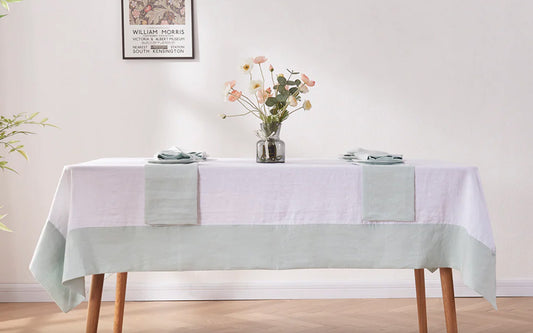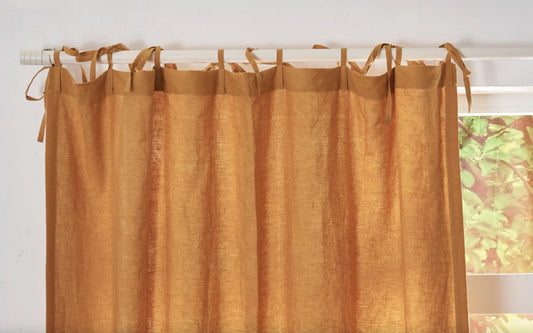From lightweight button-downs perfect for summer vacation destinations to luxurious bedding made to feel inviting, linen fabric is a popular textile. And with good reason! If you're interested in purchasing a few yards of stylish linen, you ought to know a thing or two before you buy. Follow along as we answer the most common questions about linen fabric.
Why the World Loves Linen
Linen has been a unique and beloved fabric around the world for centuries. Whether you're using it for a natural duvet cover or a skirt, linen is known for being lightweight, breathable, and temperature-regulating, offering comfort at any time of year. The flax fibers are strong, durable, and resistant to a lot of pesky dander and dust, making it a great choice for year-round use.
With a natural, rustic wrinkle and a flowy feel, linen is also a champion of style. From elegantly set white tablecloths to dramatic ivory dust ruffles, linen brings a level of sophistication and timeless aesthetic to any room in the house. Experiment with a matching linen bedding set for a clean, minimalist look, or pair a rainbow of table linens together for an eclectic maximalist design—the choices are endless.
7 Common Questions About Linen Fabric
Whether you're looking to buy raw linen to design cottagecore styles you love or are interested in investing in linen sheets for your bedroom revamp, there's plenty to learn about linen fabric. We've answered the seven most common questions to help you make educated choices:
Question 1: How is Linen Made?
Linen fabric is made using a long and tedious process—but every step is worth it. After 100 days of growth, the seeds of a flax plant are ready to be harvested and retted, a process where the fiber is separated from the woody interior of the seed. Each fiber is then rolled to separate the bast, combed to distinguish between long and short strands, and spun and reeled to create a strong, waivable thread. Once each spool is dry, the spool or bobbin of linen can be used to create all kinds of household products.
Question 2: What Are the 4 Categories of Linen?
- Damask: this is the standard linen fabric choice for ornate and delicate table linens.
- Plain-woven: this style is extra absorbent and naturally checkered, making it perfect for reusable napkins.
- Loose-woven: while it's not as durable as the others, this is a premium linen choice for cotton-blend garments.
- Sheeting: also called close-weaved, this remarkably soft variety is popular for comfortable linen bedding.
Question 3: Does Linen Fabric's Thread Count Matter?
Thread count is commonly used as a buzzword to persuade you to buy a certain kind of bedding, and while linen fabric does technically have a thread count, it's not something that matters when it comes to quality. Linen's thread count is generally between 80 and 150, which is considered low when compared to Egyptian cotton or silk, but the reality is that thread count does not necessarily guarantee durability or quality.
Question 4: How is Linen Fabric Graded?
When you're shopping for linen fabric of your own, don't get caught up on the thread count. Beautiful linen is better graded using the GSM, or "grams per square meter" scale, which refers to how many grams one square meter weighs. The higher the number, the denser the fabric is—luckily, there are linen fabrics at varying GSMs.
Typical Linen Fabric GSM Chart:
- Lightweight linen—100-170 GSM, perfect for sewing breezy garments such as loose pants or thin blouses.
- Midweight—170-340 GSM, ideal for cozy and breathable bedding and pillowcases.
- Heavyweight—340-400 GSM, best for heavier and durable table runners and placemats.
Question 5: What Can Linen Fabric Be Used For?
From household goods to stylish apparel, linen is known for its versatility. Whether you're browsing our beautiful designs or looking to sew something for yourself, linen can be made into:
- Tablecloths
- Placemats
- Napkins
- Curtains
- Towels
- Bedsheets
- Clothing
- Pillowcases
- … and more!
Question 6: Should Linen Fabric Be Prewashed?
Linen is famous for the fact that it softens with each wash and wear, so don't panic if your linen fabric feels a little stiff when you first buy it. Before you work on your linen creation, just give it a little prewash in hot water to prevent shrinkage in the future. This can mean running it through your washing machine on the hot setting or letting it soak in a deep bucket of steaming water.
Trustworthy companies, like Linenforce, ensure that every linen product comes prewashed, so it’s ready for use right out of the package and doesn't shrink in your laundry room the first time you run it through.
Question 7: Why is Linen Expensive?
Even though linen fabric is widely used for all sorts of products, it's still considered a luxury fabric. When you see the price tag, don't fret! The value of linen reflects the time it takes to produce the flax-spun material, the craftsmanship of the product, and the fact that you're paying for a piece of fabric that is designed to last through years and years of use.
Linen is also an environmentally friendly choice when compared to cotton and other fabrics, so every purchase feels green. Investing in a few linen bedding pieces is better for the earth in the long run than having to rebuy a cheaper, weaker product every few years.
Options for Dying 100% Linen Fabric
Linen is naturally a warm tan hue, which offers a down-to-earth feel for any clothing or bedding, but sometimes, you may want a more vibrant color. Because linen fibers can handle high temperatures, most colors of dye penetrate the fabric with no problem. If you need to dye your linen fabric, you can either use typical box dye directions (such as Rit) or fiber-active dye in a hot bucket or stovetop.
Linen can be used for just about anything, from sleep-benefitting blackout curtains to aprons and more. With these seven popular questions answered, you're ready to hit the shops and buy the linen fabric of your dreams. So, what are you waiting for?






